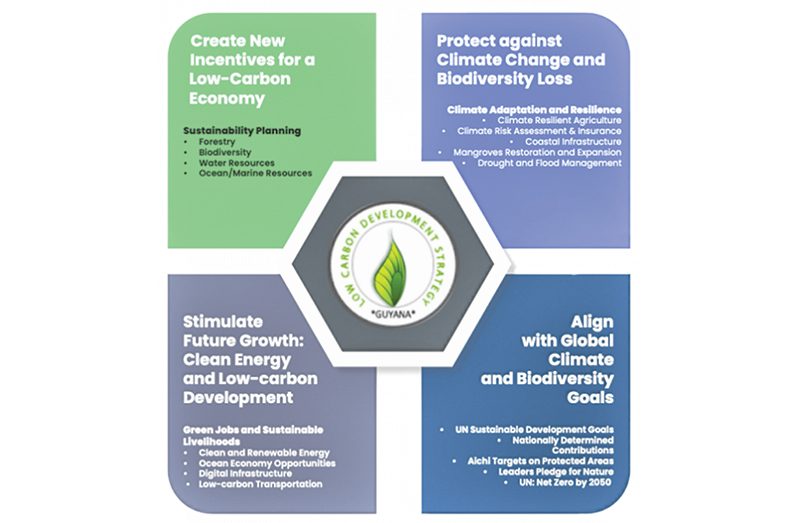WITH one of the fastest-growing economies, Guyana is leading the world in producing carbon credits from its huge tropical forest.
As a result of a contract signed in December 2022 between the Guyanese government and Hess Corporation, Guyana has begun to receive payments for its first carbon credits under the Architecture for REDD+ transactions, TREES Standard, building on a programme that has long been in the works. ART TREES is the international certifying standard for Guyana’s carbon credits.
Hess will buy 37.5 million carbon credits from Guyana between 2022 and 2032 for a minimum of $750 million. According to Vice President Bharrat Jagdeo, if the credits appreciate when traded in secondary markets, the arrangement could generate much more money than that. A way to value the carbon trees store is by issuing forest carbon credits by independent verification organisations. Companies can purchase these tradable credits as a way of recognising that carbon stored in forests is one aspect of the solution to achieving a global climate where one metric ton of carbon dioxide has been decreased, avoided, or sequestered for every carbon credit.
In mid-February, Vice President Jagdeo stated at the International Energy Conference and Expo Guyana 2023 in Georgetown, Guyanese capital, that 15 per cent of the proceeds from Guyana’s carbon credits will go directly to Amerindian villages in the country’s hinterland; “recognising the role that Indigenous Villages have played in maintaining Guyana’s forests.” Since then, Government has disbursed over US$$22.5 million to bank accounts of over 240 villages for investment in village development activities.
According to Dr. Jagdeo, the contract with Hess accounted for approximately 30 per cent of Guyana’s internationally recognised carbon credits, and the government may conclude further deals of this nature in the future. He states that Guyana plays a significant role in storing and sequestering carbon from the atmosphere due to its nearly 85 per cent forest cover.
“We’re making our contribution to the global fight against climate change, and we are monetising these resources and utilising these for the development of our country,” he said.
An estimated 18 million hectares of largely intact forests are found in Guyana, a country that is a part of the Amazon Basin. This is a larger area than Florida in the United States or Uruguay in South America. According to government statistics, these forests hold roughly 20 billion tons of carbon dioxide, taking about 154 million tonnes of CO2 out of the atmosphere yearly.
The President of Guyana, Dr. Irfaan Ali also spoke at the conference and emphasised the need for the world to advance in understanding the economic potential of carbon storage and biodiversity. He added that Guyana should celebrate the success represented by the newly inked accord.
“This is visionary, proactive, sustainable, and it catalyses the value of our natural resources,” he said. President Ali added that the agreement is consistent with Guyana’s Low Carbon Development Strategy 2030, which he said he hoped would become “a global model for sustainability.”
Vice President Jagdeo, who presided over Guyana from 1999 to 2011, also stated during a panel discussion at the most recent energy conference that his nation began looking into the potential of payment for forest preservation in 2007.
Dr. Jagdeo asked, “We thought, what if we were to deploy our forests in the fight against climate change? Would there be enough global incentives to allow us to outcompete alternate use for the forests?”
He stated that although some would argue against any tree cutting, it is a reality that people rely on the forests for a life.
“Clearly, we had to find a balanced approach that would allow people to continue to have a respectable living off of the forest, but at the same time preserve these forests, because if we don’t do that, we’ll never achieve net zero,” Vice President Jagdeo explained, adding that deforestation and land degradation account for about 16 per cent of the world’s greenhouse gas emissions and Guyana has taken the alternative path of sustainable management.
To determine the potential economic benefit to the country if Guyana were to clear most of its forests and use the land for anything else, like mining or agriculture, the country hired the international consulting company McKinsey & Company to conduct a study. According to the analysis, the nation could earn an annuity of close to $600 million, making preservation a viable alternative if it could someday generate that income without cutting down trees. Guyana has opted to pursue a low-carbon pathway that maintains forests whilst supporting sustainable development. LCDS 2030 charts the path of low-carbon development for Guyana.
(This is part of a weekly series on LCDS.) The author can be contacted at cparkinson0206@gmail.com.)





.jpg)








